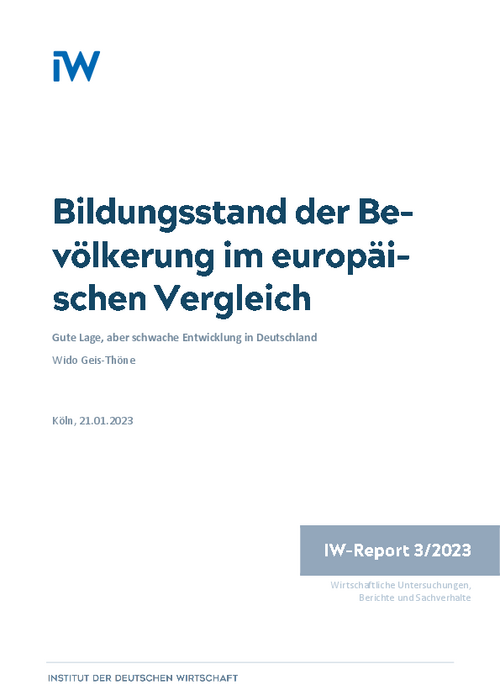With the increasing shortage of skilled labour against the backdrop of demographic change and the changing demands on employees in the context of digitalisation, decarbonisation and de-globalisation, it is becoming increasingly important for Germany and Europe that the working population achieves the highest possible level of qualification.

Educational attainment of the population in a European comparison

With the increasing shortage of skilled labour against the backdrop of demographic change and the changing demands on employees in the context of digitalisation, decarbonisation and de-globalisation, it is becoming increasingly important for Germany and Europe that the working population achieves the highest possible level of qualification.
In recent years, a strong expansion of education has taken place throughout the EU. The proportion of low-skilled workers between the ages of 25 and 64 without a vocational qualification or higher education entrance qualification fell from 27.0 percent to 20.7 percent in the years from 2011 to 2021 alone. This was mainly due to very positive developments in Southern Europe. In Germany, on the other hand, there was even a slight increase from 13.4 percent to 15.2 percent. Looking only at persons between 25 and 24 years, the figure for Germany of 14.6 per cent in 2021 was only marginally below the average of 14.8 per cent for the 27 EU countries. At the same time, the share of highly qualified people with tertiary education in this age group was significantly lower in Germany at 35.7 percent compared to 41.2 percent on average in the EU. However, this should be seen against the background of the very special position of vocational education and training in Germany in an international comparison. If one looks at the persons with tertiary and secondary vocational education and training at the age of 25 to 34 years together, one arrives at a significantly higher share for Germany with 77.0 percent than for the EU as a whole with 73.4 percent. However, the corresponding figure for older persons aged 55 to 64 is much higher in Germany at 82.8 per cent and much lower in the EU as a whole at 63.1 per cent.
The reasons for this unfavourable development lie not only in the German education system, but also in migration. In 2021, immigrants between the ages of 25 and 34 were far more likely to be low-skilled, with a share of 29.9 per cent, than those born in Germany, with 10.0 per cent. A similar picture emerges for most other northern, western and southern European countries. Only Ireland stands out strongly here with very highly qualified immigration. Nevertheless, Germany should counteract this with targeted migration and integration policy measures. On the one hand, these should be aimed at strengthening employment and education immigration, where the qualification level of the immigrants can be controlled. On the other hand, they should create opportunities and incentives for people coming to the country in other contexts to receive further qualification soon after their entry, which is not limited to the linguistic area, and, if not already available and reasonably possible, to also acquire a vocational qualification. In the education system, the federal states should ensure through early and intensive support that, if possible, all children and young people growing up in the country are later able to acquire a vocational qualification. At the same time, they should also keep an eye on the better-performing children and young people and ensure that their acquisition of skills and educational qualifications is also promoted in the best possible way and that they are prepared in a targeted manner for the changing world of work and life due to digitalisation and decarbonisation.

Educational attainment of the population in a European comparison

More on the topic

Securing skilled workers through immigration to universities
Against the backdrop of demographic change, Germany is increasingly dependent on skilled labour from abroad to secure growth and prosperity.
IW
Record immigration not only due to flight from Ukraine
In 2022, more people immigrated to Germany than ever before in the history of the Federal Republic. Around 1.46 million more people moved here than left the country, which is more than a quarter more than the previous record of 1.14 million from 2015.
IW